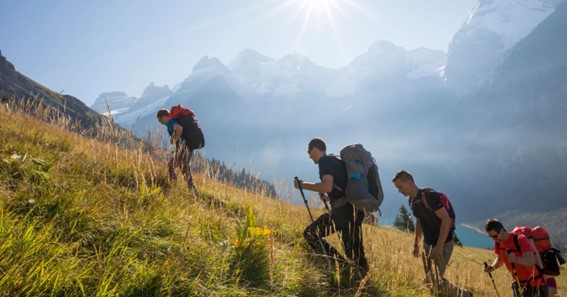Hiking is not only a great way to explore the outdoors and enjoy beautiful landscapes, but it also offers numerous benefits for your physical, mental, and emotional well-being. It is an excellent form of exercise that engages your entire body and helps improve cardiovascular health, increases endurance, and builds strength in your muscles, particularly in your legs, core, and glutes.
Spending time in nature also has a positive impact on mental health. Hiking allows you to disconnect from the stresses of daily life and connect with the natural world. It promotes relaxation, reduces anxiety and depression, and improves overall mood. Being surrounded by greenery and fresh air can have a rejuvenating effect on your mind, helping to alleviate mental fatigue and improve cognitive function. Hiking provides a break from the demands and pressures of modern life. It offers a chance to unwind, recharge, and immerse yourself in the tranquillity of nature. The rhythmic movement of walking combined with the soothing sounds and sights of the wilderness can lower stress levels, promote mindfulness, and enhance your overall sense of well-being. Spending time outdoors exposes you to natural sunlight, allowing your body to produce vitamin D, which is essential for bone health and immune function.
Hiking is also fantastic for socialising, providing opportunities to connect with friends, family, or fellow hikers. Engaging in conversations, sharing experiences, and enjoying the journey together can strengthen relationships and foster a sense of community. But how can you get involved in hiking and the hiking community? Let’s take a look.
Click Here – 10 Highly Creative Things You Can Do With Your Dog This Summer
How to join a hiking group
Joining a hiking group is a wonderful way to meet like-minded individuals, enhance your hiking experience, and explore new trails together.
Here are some tips to help you get started:
- Research Hiking Groups: Look for local hiking groups or clubs in your area. Check online platforms, such as social media, hiking forums, or websites dedicated to outdoor activities. You can also inquire at local outdoor stores or visitor centers for recommendations. Read reviews, explore their websites or social media pages, and get a sense of their values, interests, and the types of hikes they organize.
- Determine Your Preferences: Consider what kind of hiking group you’d like to join. Are you interested in casual day hikes or more challenging overnight trips? Do you prefer groups that focus on a specific theme, such as nature photography or bird watching? Clarify your preferences and find a group that aligns with your interests and skill level.
- Attend Meetup Events: Many hiking groups organise meetup events where newcomers are welcome. These events provide an opportunity to meet the group members, hike with them, and get a feel for the dynamics. Check if the group you’re interested in has any upcoming events or outings and make plans to attend. It’s a great way to introduce yourself and see if you enjoy their company.
- Start Small: If you’re new to hiking or group activities, consider joining shorter and easier hikes initially. This allows you to gradually build your confidence, assess your compatibility with the group, and determine if their pace and hiking style suit your preferences. As you gain experience and feel more comfortable, you can gradually participate in longer or more challenging hikes.
- Communicate and Ask Questions: Don’t hesitate to reach out to the hiking group’s organisers or members with any questions you may have. Inquire about their hike difficulty levels, gear requirements, and any specific guidelines they follow. This communication will help you prepare adequately and ensure that you have a positive experience.
- Be Respectful and Follow Group Etiquette: When joining a hiking group, it’s essential to adhere to their established rules and etiquette. Respect the group’s values, hiking pace, and safety guidelines. Be considerate towards other members, the environment, and local regulations. Communicate openly and honestly, and maintain a positive attitude.
- Contribute and Connect: Actively participate in the group’s activities, engage in conversations, and share your own hiking experiences. Offer assistance, advice, or expertise when appropriate. By contributing and building connections, you’ll develop stronger relationships within the group and create a sense of camaraderie.
Every hiking group is different, so it may take some trial and error to find the one that best suits your needs and preferences. Don’t be discouraged if the first group you try isn’t the perfect fit. Keep exploring different options until you find a hiking group that aligns with your goals and fosters a supportive and enjoyable hiking experience.
Hiking Equipment for Beginners
For newcomers to hiking, essential equipment includes proper hiking shoes or boots for support and traction, moisture-wicking clothing for comfort, a backpack to carry essentials, navigation tools like a map and compass, an adequate water supply and hydration system, snacks or food for energy, sun protection with a hat, sunglasses, and sunscreen, a basic first aid kit, trekking poles for stability, and a headlamp or flashlight for low-light conditions.
It’s important to choose gear that is comfortable, appropriate for the terrain, and promotes safety and enjoyment on the trails.
Look for the best hiking equipment today and begin your outdoor adventure.
